Imaging Microscope Objectives, Dry
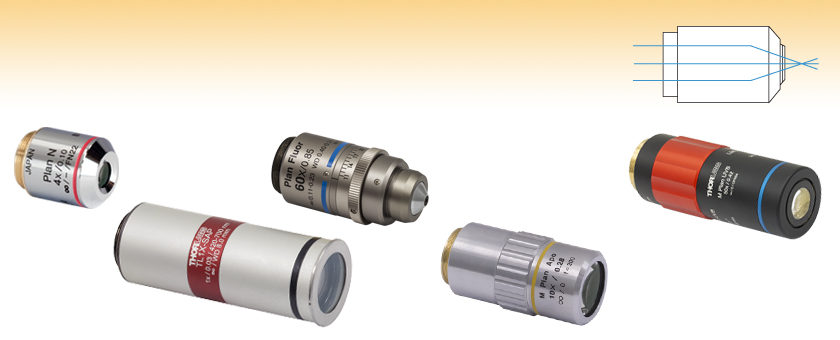
- Infinity-Corrected Microscope Objectives for UV, Visible, and NIR
- Designed for Use with Air between Objective and Sample or Cover Glass
- Magnifications Ranging from 1X to 100X
- Super Apochromat, Plan Achromat, Plan Apochromat VIS+, Plan Apochromat, and Plan Fluorite Designs
RMS4X
4X Plan Achromat
for Visible Wavelengths
TL1X-SAP
1X Super Apochromat
for 420 to 700 nm
N60X-PF
60X Plan Fluorite
for UV to NIR Wavelengths
MY10X-803
10X Plan Apochromat
for 480 to 1800 nm
LMUL-50X-UVB
50X Plan Achromat
for 240 to 360 nm

Please Wait
| Objective Lens Selection Guide |
|---|
| Objectives |
| Microscopy Objectives for Life Sciences, Dry Microscopy Objectives, Dry Microscopy Objectives, Oil Immersion Physiology Objectives, Water Dipping or Immersion Phase Contrast Objectives Long Working Distance Objectives Reflective Microscopy Objectives UV Focusing Objectives VIS and NIR Focusing Objectives |
| Scan Lenses and Tube Lenses |
| Scan Lenses F-Theta Scan Lenses Infinity-Corrected Tube Lenses |

Did You Know?
Multiple optical elements, including the microscope objective, tube lens, and eyepieces, together define the magnification of a system. See the Magnification & FOV tab to learn more.
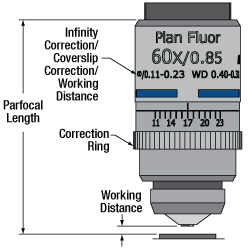
Click for Details
Example of a Dry Objective Design
(See Objective Tutorial Tab for More Information About Microscope Objective Types)
Thorlabs offers dry objectives made in house, as well as objectives from Olympus, Nikon, and Mitutoyo. Super apochromat, plan achromat, plan apochromat VIS+, plan apochromat, and plan fluorite (also called plan semi-apochromat or plan fluor) designs are available. For details about the differences between these types of objectives, please see the Objective Tutorial tab above.
When choosing a microscope objective, it is important to keep in mind that objectives are often designed to integrate with a particular manufacturer's microscopes. Before interchanging objectives, be sure to check the design tube lens focal length and the threading type of the objectives. A full list of specifications for each objective can be found in the Specs tab above. Please note that the performance of each objective may vary from the engraved specifications when integrated with components and systems from different manufacturers. See the Magnification and FOV tab for more information.
Our selection of dry objectives can be used in applications from microscopy to fiber coupling and includes options optimized for use at wavelengths from the UV to the NIR. For information on recommended applications for specific objectives, see below.
All objectives featured on this page are compatible with our microscope nosepiece modules for DIY Cerna® systems, which accept RMS, M25 x 0.75, or M32 x 0.75 objective threading. Parfocal lengths can be matched by using our parfocal length extenders. The Olympus microscope objectives can be mounted directly to our fiber launch systems, or mounted into our 30 mm cage system using the CP42(/M) RMS-threaded cage plate, which is also post mountable. They can also be mounted to any of our multi-axis platforms or translation stages using an HCS013 RMS mount. Please note that the multi-axis platforms and translation stages need a 3 mm wide central keyway for the HCS013 RMS mount.
To use these objectives with a different thread standard, please see our microscope objective thread adapters.
| Quick Links | ||||
|---|---|---|---|---|
| Manufacturer | Design Tube Lens Focal Length | Available Objective Classes |
||
| Thorlabs | 200 mm | Super Apochromatic | Achromatic, Microspot®UV Focusing | Plan Apochromatic VIS+ |
| Olympus | 180 mm | Plan Achromat | Plan Fluorite | |
| Nikon | 200 mm | Plan Fluorite | ||
| Mitutoyo | 200 mm | Plan Apochromat | ||
| 1X - 7.5X Objective Specifications | ||||||||
|---|---|---|---|---|---|---|---|---|
| Magnificationa | 1Xb | 2X | 4X | 5X | 7.5X | |||
| Manufacturer | Thorlabs | Olympus | Nikon | Mitutoyo | ||||
| Item # | TL1X-SAP | TL2X-SAP | TL4X-SAP | RMS4X | RMS4X-PF | N4X-PF | MY5X-822 | MY7X-807 |
| Objective Class | Super Apochromatc | Plan Achromat | Plan Fluorite | Plan Apochromat | ||||
| Numerical Aperture (NA) | 0.03 | 0.10 | 0.20 | 0.10 | 0.13 | 0.14 | 0.21 | |
| Entrance Pupil Diameterd | 12 mm | 20 mm | 20 mm | 9.0 mm | 11.7 mm | 13 mm | 11.2 mm | |
| Effective Focal Length (EFL) | 200 mm | 100 mm | 50 mm | 45 mm | 50 mm | 40 mm | 26.7 mm | |
| Working Distance | 8.0 mm | 56.3 mm | 17.0 mm | 18.5 mm | 17 mm | 17.2 mm | 37.5 mm | 35.0 mm |
| Resolutione | 11.2 μm | 3.4 μm | 1.7 μm | 3.4 μm | 2.6 μm | 2.6 μm | 2.4 μm | 1.6 μm |
| Parfocal Length | 95.0 mm | 60.0 mm | 45.06 mm | 60 mm | 95 mm | |||
| Design Tube Lens Focal Length | 200 mm | 180 mm | 200 mm | |||||
| Coverglass Thickness | 0 - 5.0 mm | 0 - 0.17 mm | 0 mm | |||||
| Diameter | 32.6 mm (Without Wave Plate) |
30.5 mm | 24.0 mm | 30.0 mm | 34.0 mm | |||
| 34.5 mm (With Wave Plate) |
||||||||
| Length | 85.5 mm (Without Wave Plate) |
43.5 mm | 46.4 mm | 30.9 mm | 32.4 mm | 46.6 mm | 62.5 mm | 65.0 mm |
| 90.6 mm (With Wave Plate) |
||||||||
| Threading | M25 x 0.75 | RMS | M25 x 0.75 | W26 x 0.706 | ||||
| Threading Depth | 3.8 mm | 3.2 mm | 3.6 mm | 4.5 mm | 3.6 mm | 5.0 mm | ||
| Wavelength Range | 420 - 700 nm | 350 - 700 nm | Visible | Visible to NIR | UV to NIR | 480 - 1800 nm | 436 - 656 nm | |
| Antireflection Coating | Ravg < 0.5% (420 - 700 nm) |
Ravg < 0.5% (350 - 700 nm) |
Proprietary | |||||
| Field of View | Ø22 mm | Ø11 mm | Ø5.5 mm | Ø6.625 mm | Ø6.25 mm | Ø4.8 mm | Ø3.2 mm | |
| Optical Field Number | 22 | 26.5 | 25 | 24 | ||||
| Coverslip Correction Collar | No | |||||||
| 10X - 15X Objective Specifications | ||||||||
|---|---|---|---|---|---|---|---|---|
| Magnificationa | 10X | 15X | ||||||
| Manufacturer | Olympus | Nikon | Mitutoyo | Thorlabs | ||||
| Item # | RMS10X | RMS10X-PF | N10X-PF | MY10X-823 | MY10X-803 | LMUL-10X-UVB | TL10X-2P | TL15X-2P |
| Objective Class | Plan Achromat | Plan Fluorite | Plan Apochromat | Achromat | Super Apochromatb | Plan Apochromat VIS+b | ||
| Numerical Aperture (NA) | 0.25 | 0.3 | 0.26 | 0.28 | 0.25 | 0.50 | 0.70 | |
| Entrance Pupil Diameterc | 9.0 mm | 10.8 mm | 12 mm | 10.4 mm | 11.2 mm | 10.0 mm | 20.0 mm | 18.6 |
| Effective Focal Length (EFL) | 18 mm | 20 mm | 20 mm | 13.3 mm | ||||
| Working Distance | 10.6 mm | 10 mm | 16 mm | 31 mm | 34 mm | 20.0 mm | 7.77 mm | 2.6 mmd |
| Resolutione | 1.3 μm | 1.1 μm | 1.3 μm | 1.2 μm | 0.9 μm | 0.7 μm | 0.5 μm | |
| Parfocal Length | 45.06 mm | 60 mm | 95 mm | 95.0 mm | 75.0 mm | |||
| Design Tube Lens Focal Length | 180 mm | 200 mm | ||||||
| Cover Glass Thickness | 0 - 0.17 mm | 0.17 | 0 mm | 0 mm | 0 - 2.6 mm | 0 - 2.8 mm | ||
| Diameter | 24.0 mm | 30.0 mm | 34.0 mm | 34.0 mm | 40.6 mm | 38.1 mm | ||
| Length | 38.8 mm | 39.4 mm | 48.7 mm | 68.5 mm | 66.0 mm | 80.0 mm | 90.4 mm | 76.9 mm |
| Threading | RMS | M25 x 0.75 | W26 x 0.706 | W26 x 0.706 | M32 x 0.75 | |||
| Threading Depth | 4.5 mm | 5.0 mm | 5.0 mm | 3.2 mm | 4.5 mm | |||
| Wavelength Range | Visible | Visible to NIR | UV to NIR | 480 - 1800 nm | 436 - 656 nm | 240 - 360 nm | 400 - 1300 nm | |
| Antireflection Coating | Proprietary | <1.5% per Surface (240 - 360 nm) |
Rabs < 3% (400 - 450 nm) Rabs < 2%(450 - 1300 nm) @ 0° - 25° AOI |
|||||
| Field of View | Ø2.2 mm | Ø2.65 mm | Ø2.5 mm | Ø2.4 mm | Ø2.2 mm | Ø1.5 mm | ||
| Optical Field Number | 22 | 26.5 | 25 | 24 | 22 | |||
| Coverslip Correction Collar | No | Yes | ||||||
| 20X Objective Specifications | ||||||
|---|---|---|---|---|---|---|
| Magnificationa | 20X | |||||
| Manufacturer | Thorlabs | Olympus | Nikon | Mitutoyo | ||
| Item # | LMUL-20X-UVB | RMS20X | RMS20X-PF | N20X-PF | MY20X-804 | MY20X-824 |
| Objective Class | Achromat | Plan Achromat | Plan Fluorite | Plan Apochromat | ||
| Numerical Aperture (NA) | 0.36 | 0.4 | 0.5 | 0.42 | 0.40 | |
| Entrance Pupil Diameterb | 7.2 mm | 9.0 mm | 10 mm | 8.4 mm | 8.0 mm | |
| Effective Focal Length (EFL) | 10 mm | 9 mm | 10 mm | |||
| Working Distance | 15.3 mm | 1.2 mm | 2.1 mm | 20.0 mm | ||
| Resolutionc | 0.6 μm | 0.8 μm | 0.7 μm | 0.8 μm | ||
| Parfocal Length | 95.0 mm | 45.06 mm | 60 mm | 95.0 mm | ||
| Design Tube Lens Focal Length | 200 mm | 180 mm | 200 mm | |||
| Cover Glass Thickness | 0 mm | 0.17 mm | 0 mm | |||
| Diameter | 34.0 mm | 24.0 mm | 26.0 mm | 28.0 mm | 34.0 mm | |
| Length | 84.7 mm | 48.5 mm | 47.3 mm | 63.5 mm | 80.0 mm | |
| Threading | W26 x 0.706 | RMS | M25 x 0.75 | W26 x 0.706 | ||
| Threading Depth | 5.0 mm | 4.8 mm | 4.5 mm | 5.0 mm | ||
| Wavelength Range | 240 - 360 nm | Visible | Visible to NIR | UV to NIR | 436 - 656 nm | 480 - 1800 nm |
| Antireflection Coating | <1.5% per Surface (240 - 360 nm) |
Proprietary | ||||
| Field of View | Ø1.2 mm | Ø1.1 mm | Ø1.325 mm | Proprietary | Ø1.2 mm | |
| Optical Field Number | 24 | 22 | 26.5 | Proprietary | 24 | |
| Coverslip Correction Collar | No | |||||
| 40X - 50X Objective Specifications | |||||||
|---|---|---|---|---|---|---|---|
| Magnificationa | 40X | 50X | |||||
| Manufacturer | Olympus | Nikon | Thorlabs | Mitutoyo | |||
| Item # | RMS40X | RMS40X-PF | N40X-PF | LMUL-50X-UVB | HPA50XAB | MY50X-805 | MY50X-825 |
| Objective Class | Plan Achromat | Plan Fluorite | Achromat | Plan Apochromat VIS+b | Plan Apochromat | ||
| Numerical Aperture (NA) | 0.65 | 0.75 | 0.42 | 0.75 | 0.55 | 0.42 | |
| Entrance Pupil Diameterc | 5.8 mm | 6.8 mm | 7.5 mm | 3.4 mm | 6.0 mm | 4.4 mm | 3.4 mm |
| Effective Focal Length (EFL) | 4.5 mm | 5.0 mm | 4 mm | 4.0 mm | |||
| Working Distance | 0.6 mm | 0.51 mm | 0.66 mm | 12.0 mm | 5.0 mm | 13.0 mm | 17.0 mm |
| Resolutiond | 0.5 μm | 0.4 μm | 0.5 μm | 0.4 μm | 0.6 μm | 0.8 μm | |
| Parfocal Length | 45.06 mm | 60 mm | 95.0 mm | 95 mm | |||
| Design Tube Lens Focal Length | 180 mm | 200 mm | |||||
| Cover Glass Thickness | 0.17 mm | 0 mm | |||||
| Diameter | 24.0 mm | 26.0 mm | 30.0 mm | 34.0 mm | |||
| Length | 48.8 mm | 48.9 mm | 59.1 mm | 88.0 mm | 95.0 mm | 87.0 mm | 82.4 mm |
| Threading | RMS | M25 x 0.75 | W26 x 0.706 | ||||
| Threading Depth | 4.5 mm | 5.1 mm | 5.0 mm | ||||
| Wavelength Range | Visible | Visible to NIR | UV to NIR | 240 - 360 nm | 400 - 1100 nme | 436 - 656 nm | 480 - 1800 nm |
| Antireflection Coating | Proprietary | <1.5% per Surface (240 - 360 nm) |
Ravg<1.0% (400 - 1100 nm) |
Proprietary | |||
| Field of View | Ø0.55 mm | Ø0.663 mm | Ø0.625 mm | Ø0.48 mm | |||
| Optical Field Number | 22 | 26.5 | 25 | 24 | |||
| Coverslip Correction Collar | No | ||||||
| 60X - 100X Objective Specifications | |||
|---|---|---|---|
| Magnificationa | 60X | 100X | |
| Manufacturer | Olympus | Nikon | Mitutoyo |
| Item # | RMS60X-PFC | N60X-PF | MY100X-806 |
| Objective Class | Plan Fluorite | Plan Apochromat | |
| Numerical Aperture (NA) | 0.9 | 0.85 | 0.70 |
| Entrance Pupil Diameterb | 5.4 mm | 5.7 mm | 2.8 mm |
| Effective Focal Length (EFL) | 3.0 mm | 3.3 mm | 2.0 mm |
| Working Distance | 0.2 mm | 0.31 - 0.4 mm | 6.0 mm |
| Resolutionc | 0.4 μm | 0.5 μm | |
| Parfocal Length | 45.06 mm | 60 mm | 95 mm |
| Design Tube Lens Focal Length | 180 mm | 200 mm | 200 mm |
| Cover Glass Thickness | 0.11 - 0.23 mm | 0 mm | |
| Diameter | 31.0 mm | 31.4 mm | 34.0 mm |
| Length | 49.4 mm | 65.0 mm | 94.0 mm |
| Threading | RMS | M25 x 0.75 | W26 x 0.706 |
| Threading Depth | 4.7 mm | 5.0 mm | |
| Wavelength Range | Visible to NIR | UV to NIR | 436 - 656 nm |
| Antireflection Coating | Proprietary | ||
| Field of View | Ø0.44 mm | Ø0.42 mm | Ø0.24 mm |
| Optical Field Number | 26.5 | 25 | 24 |
| Coverslip Correction Collar | Yes | No | |
| Chromatic Aberration Correction per ISO Standard 19012-2 | ||
|---|---|---|
| Objective Class | Common Abbreviations | Axial Focal Shift Tolerancesa |
| Achromat | ACH, ACHRO, ACHROMAT | |δC' - δF'| ≤ 2 x δob |
| Semiapochromat (or Fluorite) |
SEMIAPO, FL, FLU | |δC' - δF'| ≤ 2 x δob |δF' - δe| ≤ 2.5 x δob |δC' - δe| ≤ 2.5 x δob |
| Apochromat | APO | |δC' - δF'| ≤ 2 x δob |δF' - δe| ≤ δob |δC' - δe| ≤ δob |
| Super Apochromat | SAPO | See Footnote b |
| Improved Visible Apochromat | VIS+ | See Footnotes b and c |
Parts of a Microscope Objective
Click on each label for more details.
This microscope objective serves only as an example. The features noted above with an asterisk may not be present on all objectives; they may be added, relocated, or removed from objectives based on the part's needs and intended application space.
Objective Tutorial
This tutorial describes features and markings of objectives and what they tell users about an objective's performance.
Objective Class and Aberration Correction
Objectives are commonly divided by their class. An objective's class creates a shorthand for users to know how the objective is corrected for imaging aberrations. There are two types of aberration corrections that are specified by objective class: field curvature and chromatic aberration.
Field curvature (or Petzval curvature) describes the case where an objective's plane of focus is a curved spherical surface. This aberration makes widefield imaging or laser scanning difficult, as the corners of an image will fall out of focus when focusing on the center. If an objective's class begins with "Plan", it will be corrected to have a flat plane of focus.
Images can also exhibit chromatic aberrations, where colors originating from one point are not focused to a single point. To strike a balance between an objective's performance and the complexity of its design, some objectives are corrected for these aberrations at a finite number of target wavelengths.
Five objective classes are shown in the table to the right; only three common objective classes are defined under the International Organization for Standards ISO 19012-2: Microscopes -- Designation of Microscope Objectives -- Chromatic Correction. Due to the need for better performance, we have added two additional classes that are not defined in the ISO classes.
Immersion Methods
Click on each image for more details.
Objectives can be divided by what medium they are designed to image through. Dry objectives are used in air; whereas dipping and immersion objectives are designed to operate with a fluid between the objective and the front element of the sample.
| Glossary of Terms | |
|---|---|
| Back Focal Length and Infinity Correction | The back focal length defines the location of the intermediate image plane. Most modern objectives will have this plane at infinity, known as infinity correction, and will signify this with an infinity symbol (∞). Infinity-corrected objectives are designed to be used with a tube lens between the objective and eyepiece. Along with increasing intercompatibility between microscope systems, having this infinity-corrected space between the objective and tube lens allows for additional modules (like beamsplitters, filters, or parfocal length extenders) to be placed in the beam path. Note that older objectives and some specialty objectives may have been designed with finite back focal lengths. In their inception, finite back focal length objectives were meant to interface directly with the objective's eyepiece. |
| Entrance Pupil Diameter (EP) | The entrance pupil diameter (EP), sometimes referred to as the entrance aperture diameter, corresponds to the appropriate beam diameter one should use to allow the objective to function properly. EP = 2 × NA × Effective Focal Length |
| Field Number (FN) and Field of View (FOV) |
The field number corresponds to the diameter of the field of view in object space (in millimeters) multiplied by the objective's magnification. Field Number = Field of View Diameter × Magnification |
| Magnification (M) | The magnification (M) of an objective is the lens tube focal length (L) divided by the objective's effective focal length (F). Effective focal length is sometimes abbreviated EFL: M = L / EFL . The total magnification of the system is the magnification of the objective multiplied by the magnification of the eyepiece or camera tube. The specified magnification on the microscope objective housing is accurate as long as the objective is used with a compatible tube lens focal length. Objectives will have a colored ring around their body to signify their magnification. This is fairly consistent across manufacturers; see the Parts of a Microscope Objective section for more details. |
| Numerical Aperture (NA) | Numerical aperture, a measure of the acceptance angle of an objective, is a dimensionless quantity. It is commonly expressed as: NA = ni × sinθa where θa is the maximum 1/2 acceptance angle of the objective, and ni is the index of refraction of the immersion medium. This medium is typically air, but may also be water, oil, or other substances. |
| Working Distance (WD) |
The working distance, often abbreviated WD, is the distance between the front element of the objective and the top of the specimen (in the case of objectives that are intended to be used without a cover glass) or top of the cover glass, depending on the design of the objective. The cover glass thickness specification engraved on the objective designates whether a cover glass should be used. |
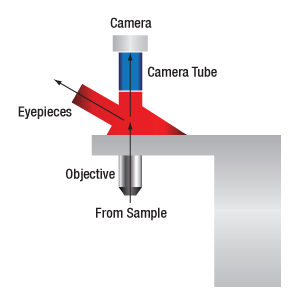
When viewing an image with a camera, the system magnification is the product of the objective and camera tube magnifications. When viewing an image with trinoculars, the system magnification is the product of the objective and eyepiece magnifications.
| Manufacturer | Tube Lens Focal Length |
|---|---|
| Leica | f = 200 mm |
| Mitutoyo | f = 200 mm |
| Nikon | f = 200 mm |
| Olympus | f = 180 mm |
| Thorlabs | f = 200 mm |
| Zeiss | f = 165 mm |
Magnification and Sample Area Calculations
Magnification
The magnification of a system is the multiplicative product of the magnification of each optical element in the system. Optical elements that produce magnification include objectives, camera tubes, and trinocular eyepieces, as shown in the drawing to the right. It is important to note that the magnification quoted in these products' specifications is usually only valid when all optical elements are made by the same manufacturer. If this is not the case, then the magnification of the system can still be calculated, but an effective objective magnification should be calculated first, as described below.
To adapt the examples shown here to your own microscope, please use our Magnification and FOV Calculator, which is available for download by clicking on the red button above. Note the calculator is an Excel spreadsheet that uses macros. In order to use the calculator, macros must be enabled. To enable macros, click the "Enable Content" button in the yellow message bar upon opening the file.
Example 1: Camera Magnification
When imaging a sample with a camera, the image is magnified by the objective and the camera tube. If using a 20X Nikon objective and a 0.75X Nikon camera tube, then the image at the camera has 20X × 0.75X = 15X magnification.
Example 2: Trinocular Magnification
When imaging a sample through trinoculars, the image is magnified by the objective and the eyepieces in the trinoculars. If using a 20X Nikon objective and Nikon trinoculars with 10X eyepieces, then the image at the eyepieces has 20X × 10X = 200X magnification. Note that the image at the eyepieces does not pass through the camera tube, as shown by the drawing to the right.
Using an Objective with a Microscope from a Different Manufacturer
Magnification is not a fundamental value: it is a derived value, calculated by assuming a specific tube lens focal length. Each microscope manufacturer has adopted a different focal length for their tube lens, as shown by the table to the right. Hence, when combining optical elements from different manufacturers, it is necessary to calculate an effective magnification for the objective, which is then used to calculate the magnification of the system.
The effective magnification of an objective is given by Equation 1:
 |
(Eq. 1) |
Here, the Design Magnification is the magnification printed on the objective, fTube Lens in Microscope is the focal length of the tube lens in the microscope you are using, and fDesign Tube Lens of Objective is the tube lens focal length that the objective manufacturer used to calculate the Design Magnification. These focal lengths are given by the table to the right.
Note that Leica, Mitutoyo, Nikon, and Thorlabs use the same tube lens focal length; if combining elements from any of these manufacturers, no conversion is needed. Once the effective objective magnification is calculated, the magnification of the system can be calculated as before.
Example 3: Trinocular Magnification (Different Manufacturers)
When imaging a sample through trinoculars, the image is magnified by the objective and the eyepieces in the trinoculars. This example will use a 20X Olympus objective and Nikon trinoculars with 10X eyepieces.
Following Equation 1 and the table to the right, we calculate the effective magnification of an Olympus objective in a Nikon microscope:
 |
The effective magnification of the Olympus objective is 22.2X and the trinoculars have 10X eyepieces, so the image at the eyepieces has 22.2X × 10X = 222X magnification.
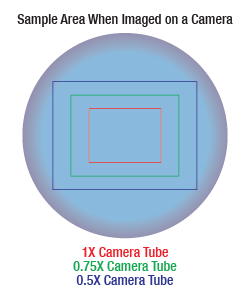
Sample Area When Imaged on a Camera
When imaging a sample with a camera, the dimensions of the sample area are determined by the dimensions of the camera sensor and the system magnification, as shown by Equation 2.
 |
(Eq. 2) |
The camera sensor dimensions can be obtained from the manufacturer, while the system magnification is the multiplicative product of the objective magnification and the camera tube magnification (see Example 1). If needed, the objective magnification can be adjusted as shown in Example 3.
As the magnification increases, the resolution improves, but the field of view also decreases. The dependence of the field of view on magnification is shown in the schematic to the right.
Example 4: Sample Area
The dimensions of the camera sensor in Thorlabs' previous-generation 1501M-USB Scientific Camera are 8.98 mm × 6.71 mm. If this camera is used with the Nikon objective and trinoculars from Example 1, which have a system magnification of 15X, then the image area is:
 |
Sample Area Examples
The images of a mouse kidney below were all acquired using the same objective and the same camera. However, the camera tubes used were different. Read from left to right, they demonstrate that decreasing the camera tube magnification enlarges the field of view at the expense of the size of the details in the image.
Resolution Tutorial
An important parameter in many imaging applications is the resolution of the objective. This tutorial describes the different conventions used to define an objective's resolution. Thorlabs provides the theoretical Rayleigh resolution for all of the imaging objectives offered on our site; the other conventions are presented for informational purposes.
Resolution
The resolution of an objective refers to its ability to distinguish closely-spaced features of an object. This is often theoretically quantified by considering an object that consists of two point sources and asking at what minimum separation can these two point sources be resolved. When a point source is imaged, rather than appearing as a singular bright point, it will appear as a broadened intensity profile due to the effects of diffraction. This profile, known as an Airy disk, consists of an intense central peak with surrounding rings of much lesser intensity. The image produced by two point sources in proximity to one another will therefore consist of two overlapping Airy disk profiles, and the resolution of the objective is therefore determined by the minimum spacing at which the two profiles can be uniquely identified. There is no fundamental criterion for establishing what exactly it means for the two profiles to be resolved and, as such, there are a few criteria that are observed in practice. In microscopic imaging applications, the two most commonly used criteria are the Rayleigh and Abbe criteria. A third criterion, more common in astronomical applications, is the Sparrow criterion.
Rayleigh Criterion
The Rayleigh criterion states that two overlapping Airy disk profiles are resolved when the first intensity minimum of one profile coincides with the intensity maximum of the other profile [1]. It can be shown that the first intensity minimum occurs at a radius of 1.22λf/D from the central maximum, where λ is the wavelength of the light, f is the focal length of the objective, and D is the entrance pupil diameter. Thus, in terms of the numerical aperture (NA = 0.5*D/f), the Rayleigh resolution is:
rR = 0.61λ/NA
An idealized image of two Airy disks separated by a distance equal to the Rayleigh resolution is shown in the figure to the left below; the illumination source has been assumed to be incoherent. A corresponding horizontal line cut across the intensity maxima is plotted to the right. The vertical dashed lines in the intensity profile show that the maximum of each individual Airy disk overlaps with the neighboring minimum. Between the two maxima, there is a local minimum which appears in the image as a gray region between the two white peaks.
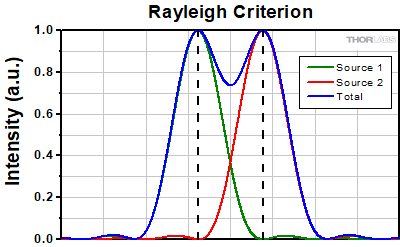 Click to Enlarge
Click to EnlargeLeft: Two point sources are considered resolved when separated by the Rayleigh resolution. The gray region between the two white peaks is clearly visible.
Above: The vertical dashed lines show how the maximum of each intensity profile overlaps with the first minimum of the other.
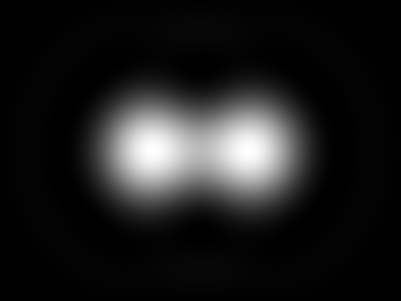
Thorlabs provides the theoretical Rayleigh resolution for all of the imaging objectives offered on our site in their individual product presentations.
Abbe Criterion
The Abbe theory describes image formation as a double process of diffraction [2]. Within this framework, if two features separated by a distance d are to be resolved, at a minimum both the zeroth and first orders of diffraction must be able to pass through the objective's aperture. Since the first order of diffraction appears at the angle: sin(θ1) = λ/d, the minimum object separation, or equivalently the resolution of the objective, is given by d = λ/n*sin(α), where α is the angular semi-aperture of the objective and a factor of n has been inserted to account for the refractive index of the imaging medium. This result overestimates the actual limit by a factor of 2 because both first orders of diffraction are assumed to be accepted by the objective, when in fact only one of the first orders must pass through along with the zeroth order. Dividing the above result by a factor of 2 and using the definition of the numerical aperture (NA = n*sin(α)) gives the famous Abbe resolution limit:
rA = 0.5λ/NA
In the image below, two Airy disks are shown separated by the Abbe resolution limit. Compared to the Rayleigh limit, the decrease in intensity at the origin is much harder to discern. The horizontal line cut to the right shows that the intensity decreases by only ≈2%.
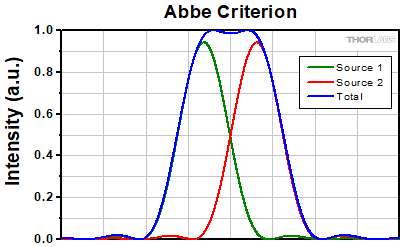 Click to Enlarge
Click to EnlargeLeft: Two point sources separated by the Abbe resolution limit. Though observable, the contrast between the maxima and central minimum is much weaker compared to the Rayleigh limit.
Above: The line cut shows the small intensity dip between the two maxima.
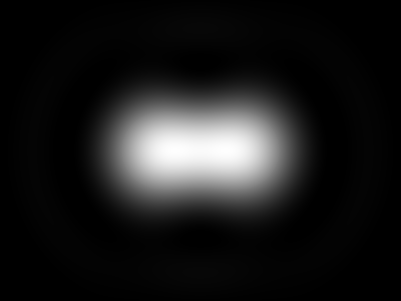
Sparrow Criterion
For point source separations corresponding to the Rayleigh and Abbe resolution criteria, the combined intensity profile has a local minimum located at the origin between the two maxima. In a sense, this feature is what allows the two point sources to be resolved. That is to say, if the sources' separation is further decreased beyond the Abbe resolution limit, the two individual maxima will merge into one central maximum and resolving the two individual contributions will no longer be possible. The Sparrow criterion posits that the resolution limit is reached when the crossover from a central minimum to a central maximum occurs.
At the Sparrow resolution limit, the center of the combined intensity profile is flat, which implies that the derivative with respect to position is zero at the origin. However, this first derivative at the origin is always zero, given that it is either a local minimum or maximum of the combined intensity profile (strictly speaking, this is only the case if the sources have equal intensities). Consider then, that because the Sparrow resolution limit occurs when the origin's intensity changes from a local minimum to a maximum, that the second derivative must be changing sign from positive to negative. The Sparrow criterion is thus a condition that is imposed upon the second derivative, namely that the resolution limit occurs when the second derivative is zero [3]. Applying this condition to the combined intensity profile of two Airy disks leads to the Sparrow resolution:
rS = 0.47λ/NA
The image to the left below shows two Airy disks separated by the Sparrow resolution limit. As described above, the intensity is constant in the region between the two peaks and there is no intensity dip at the origin. In the line cut to the right, the constant intensity near the origin is confirmed.
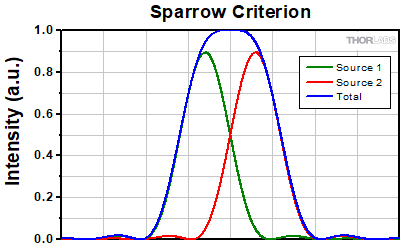 Click to Enlarge
Click to EnlargeLeft: Two Airy disk profiles separated by the Sparrow resolution limit. Note that, unlike the Rayleigh or Abbe limits, there is no decrease in intensity at the origin.
Above: At the Sparrow resolution limit, the combined intensity is a constant near the origin. The scale here has been normalized to 1.
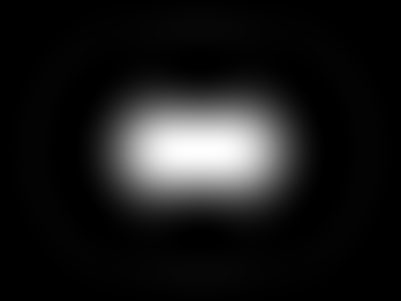
References
[1] Eugene Hecht, "Optics," 4th Ed., Addison-Wesley (2002)
[2] S.G. Lipson, H. Lipson, and D.S. Tannhauser, "Optical Physics," 3rd Ed., Cambridge University Press (1995)
[3] C.M. Sparrow, "On Spectroscopic Resolving Power," Astrophys. J. 44, 76-87 (1916)
| Posted Comments: | |
user
(posted 2024-07-05 19:58:33.233) Dear staff,
I want to know the damage threshold of RMS40X - 40X Olympus Plan Achromat Objective, 0.65 NA, 0.6 mm WD . thank you.
form jin jdelia
(posted 2024-07-09 09:35:50.0) Thank you for contacting Thorlabs. We unfortunately do not have a damage threshold for these objectives. However, as a guideline, Olympus recommends limiting the input power to <20 mW for focused light and <100 mW for collimated light. ILIYA SHOFMAN
(posted 2023-12-13 03:14:11.6) Hello,
I'm curious to know what the focal length shift would be for the RMS20X objective with respect to wavelength.
I understand the objective is a plan achromat, so it is corrected for chromatic aberration at two wavelengths. What about the "in-between" wavelengths?
Thank you!
Iliya Shofman. cdolbashian
(posted 2023-12-15 10:04:41.0) Thank you for reaching out to us with this inquiry. Unfortunately we are not privy to proprietary engineering and test data from Olympus. As you mentioned, achromatic design does indeed tend toward the two extrema wavelengths and is less controlled, but still certainly optimized, at the intermediate wavelengths. If you have the opportunity, I would recommend contacting the manufacturer of these objectives and request such information. Tianling Niu
(posted 2023-10-30 14:43:23.63) Can you include the transmission curve? Also, there's no zemax file for this objective lenses. ksosnowski
(posted 2023-11-02 11:51:46.0) Thanks for reaching out to Thorlabs. Unfortunately, Nikon does not provide transmission curves or Zemax files for their optics. It is possible they may be more receptive if you contact them directly as the actual end-user in the application however they have historically not shared this sort of info with Thorlabs. robert lammert
(posted 2023-03-30 16:06:31.41) We just ordered a RMS4X and the Parfocal distance was stated as 45mm, however, we measure near 60mm. We have other Olympus objectives on this same microscope with 45mm Parafocal distances and they are 45mm. Are there several versions of this same lens, and we got the wrong one?
Rob Lammert
VP R&D
Laser Operations cdolbashian
(posted 2023-04-03 02:29:06.0) Thank you for reaching out with this inquiry. I have contacted you directly to figure out this apparent discrepancy. David Kallweit
(posted 2023-03-17 08:58:12.227) Dear customer support,
i would like to use the RMS10X - 10X Olympus Plan Achromat Objective, 0.25 NA, 10.6 mm WD and the RMS20X - 20X Olympus Plan Achromat Objective, 0.4 NA, 1.2 mm WD in an optical simulation. But therfor I need to know the specs / configuation of all surfaces within the objective so that I can model that in my simulation software.
Would it be possible to get access to that information?
Thank you,
David jdelia
(posted 2023-03-20 10:42:29.0) Thank you for contacting Thorlabs. This is an Olympus objective, and as such we do not have any information about their simulation files. I have reached out to you directly to discuss whether there is any additional information we may be able to provide. user
(posted 2022-10-12 08:31:03.36) Is this Olympus p/n 1-U2B223? cdolbashian
(posted 2022-10-14 03:50:35.0) Thank you for reaching out to us with this inquiry. I have reached out to you to discuss the similarities of these two components. Naamah Levin
(posted 2021-12-23 07:12:55.927) Hi,
I would like to know if possible to get a zemax file of this objective (in a format of a black box) to see the ray trace and evaluate different optical elements which would be added to the optical system. YLohia
(posted 2021-12-23 10:24:13.0) Hello, thank you for contacting Thorlabs. These RMS60X-PFC objective lens is made by Olympus and, unfortunately, they do not offer Zemax (or other ray tracing) files. Michele Cotrufo
(posted 2021-11-15 12:04:36.017) Can you provide the transmission level of the objectives N20X-PF and RMS20X-PF at 1550nm ?
Also, do you have the transmission spectra of the objective RMS20X in the visible? YLohia
(posted 2021-11-23 02:04:22.0) Thank you for contacting Thorlabs. I have reached out to you directly with more information about these objectives made by Olympus. user
(posted 2021-08-09 09:17:32.58) What solvents do you suggest for cleaning the entrance lens of an objective? YLohia
(posted 2021-08-27 02:51:13.0) Hello, thank you for contacting Thorlabs. We don't have a blanket recommendation for cleaning objective. That being said, Isopropyl alcohol should work fine for our (Thorlabs brand) objectives, but for third-party objectives, we suggest contacting them directly. Is there a part in particular you are looking at? user
(posted 2021-03-20 15:35:20.147) Could you please tell me what's the back Focal Length and back work length of the RMS20X objective? Many thanks, Gao asundararaj
(posted 2021-03-26 08:09:30.0) Thank you for contacting Thorlabs. The RMS20X is an Olympus objective and all of the specifications provided for the objective can be found in the the data sheet linked here - https://www.olympus-lifescience.com/en/.pdf/en/pdf-export/objectives/?0[DIRECTORY::DirFrontend][itemId]=511706555 Obi-wan Kenobi
(posted 2021-02-27 19:32:43.037) Hi,
Could you please tell me what's the refractive index of the RMS20X objective?
Many thanks,
Jerry YLohia
(posted 2021-03-05 10:00:54.0) Hello Jerry, this objective is manufactured by Olympus and, unfortunately, they don't share refractive index information (since it is considered proprietary) with us. Ludo Angot
(posted 2020-09-16 04:38:41.34) Hello, the schematic of your TTL200 recommends a given distance between the objective lens entrance pupil plane and the tube lens. Could you please provide the location of the pupil plane for your TL2X-SAP and TL4X-SAP lenses (for example specified as the distance from the flange)? I'm not sure if the zemax file provides this information but I don't have this software. The pupil distance will also be useful to use these lenses with other tube lenses and to draw more realistic optical diagrams. Thanks! YLohia
(posted 2020-09-28 08:35:51.0) Hello, thank you for contacting Thorlabs. The pupil on the TL4X and the TL2X are both the first lens surface, so roughly on the flange shoulder. The distance required between the objective and tube lens is not a hard requirement. For example, our TTL200-A can have a pupil distance of 70-140 mm without vignetting or aberrations. user
(posted 2019-09-29 20:38:24.053) Hi, I just buy RMS20X for expanding the laser beam (632nm, HeNe Laser). The strange interference fringes (curved and light) happen after passing through the objective lens! I use the camera to observe and when I move the camera the fringes also change. Before enter the objective lens are just laser source and two mirrors. So could you tell me the reason? Thanks. YLohia
(posted 2019-10-01 09:54:02.0) Hello, thank you for contacting Thorlabs. Based on our direct troubleshooting, it has been determined that the interference fringes were being caused by the etalon effect from the thin protective (removable) window on your camera. Please also note that your 6.8mm input diameter beam needs to be carefully aligned to the center of the relatively small (7.2mm) entrance aperture of the RMS20X to prevent other beam defects. r07941046
(posted 2018-12-24 22:47:26.263) Are RMS60X-PFC and N60X-PF suitable for 1550 nm wavelength? Thank you. nbayconich
(posted 2018-12-26 01:08:54.0) Thank you for contacting Thorlabs. Transmission at 1550nm will be relatively low for both objectives and may not be suitable. Since not all of our vendors provide transmission plots to share I will reach out to you directly to discuss the ideal working range for these products. deokkihong
(posted 2018-07-30 22:48:15.767) Hi, I want to analyse a system including objective lens with opitics program like 'Code five' or 'Zemax' .
Is there any supplement data of RMS10X and RMS20X for 'Geometric optics program'? YLohia
(posted 2018-07-31 09:56:33.0) Hello, thank you for contacting Thorlabs. These two objective lenses are made by Olympus and, unfortunately, they do not offer Zemax (or other ray tracing) files. marc.miousset
(posted 2018-04-02 08:40:00.973) Hi,
Please, I need mount RSM10X, on SMIL1 or other, and they trhead, does'n work.
What ring works in the catalog Thorlabs.
Thanks
Have nice day
Marc YLohia
(posted 2018-04-03 03:27:06.0) Hello Marc, thank you for leaving feedback on our website. I wasn't able to find anything in our catalog with the part number SMIL1 -- are you referring to SM1L10? If that is the case, you can use the SM1A3 or SM1A3TS adapters to mate the RMS10X to any of our internally SM1-threaded components (for e.g., SM1L10). vinithamr
(posted 2017-06-12 19:56:18.133) hello, I want to couple free space laser beam of diameter 1mm into optical fiber P1-780PM-FC(NA 0.12). How to choose the objective lens for that especially NA and EFL. Pls help. tfrisch
(posted 2017-06-26 02:38:06.0) Hello, thank you for contacting Thorlabs. I will reach out to you about both geometric approximations for fiber coupling as well as equations needed to match the diffraction limited spot size to the mode field diameter. In the latter, I will need to know the wavelength of the source. libaikui
(posted 2017-02-10 17:19:50.68) Can the objectives be used in magnetic field ~1T? Is there any effect on the position of the spot, transmission, etc? tfrisch
(posted 2017-02-16 11:49:16.0) Hello, thank you for contacting Thorlabs. We don't have a way to test these objectives under various magnetic fields, but I will reach out to you directly about your application. naveedullah1984
(posted 2016-10-07 10:54:40.953) How can I calculate the spot size for an objective lens. I am using a collimated 635 nm Laser light. jlow
(posted 2016-10-07 04:42:44.0) Response from Jeremy at Thorlabs: The focused spot size is going to be dependent on the input beam diameter and how Gaussian your input beam is. For a Gaussian beam (M^2=1), you can use the diffraction limited spot size formula (4*λ*f)/(pi*input beam size) to estimate the spot size. egorglad
(posted 2016-09-27 07:33:55.527) Hello. Please need help. I need datashet on a RMS20X. I need data such as dispersion of lens, lenses type, Coating of lens. It's need for calculate my optical systen. jlow
(posted 2016-09-29 04:17:21.0) Response from Jeremy at Thorlabs: I will contact you directly about this. user
(posted 2016-09-26 16:52:05.52) Question to tfrisch Posted Date:2016-09-01:
In overview tab, you mention "They are designed to have high transmission, particularly at UV wavelengths"
give us a hint on how we should understand the description? tcampbell
(posted 2016-10-12 08:48:43.0) Response from Tim at Thorlabs: Thank you for your feedback. These objectives have high transmission in the near UV, visible, and near IR wavelength ranges. We have updated the web to be more clear about this. user
(posted 2016-08-26 18:46:41.743) Hello,
I am looking for a microscope objective to perform spatial filtering. This will be used in conjunction with a 325nm laser. The Nikon N40X-PF, infinity corrected seems to be a suitable option as it is designed for UV applications but I cannot find its transmittance at my wavelength of interest.
thank you tfrisch
(posted 2016-09-01 10:23:07.0) Hello, thank you for contacting Thorlabs. Unfortunately, Nikon has not shared transmission data with us. We do give UV transmission curves for our Microspot Objectives here:
https://www.thorlabs.com/newgrouppage9.cfm?objectgroup_id=3271&tabname=Graphs stefano.minardi
(posted 2016-02-23 14:48:52.153) Dear Sirs,
I'm planning to use the objective RMS40X to focus a 10W CW laser beam at a wavelength of 1550 nm. Is the damage threshold of the objective high enough for this application?
Thank you and best regards
Stefano Minardi besembeson
(posted 2016-03-08 01:46:43.0) Response from Bweh at Thorlabs USA: 10W is too high for these objectives. Olympus recommends limiting the power to under 100mW for collimated light. user
(posted 2015-12-17 11:43:32.007) Hello, does any one have experience placing these objectives into a cryostat (LN2, 77 K)? besembeson
(posted 2015-12-18 11:58:31.0) Response from Bweh at Thorlabs USA: We don't have test data on these objectives under such conditions at this time. I will check if Olympus and Nikon can provide this feedback. gtn75
(posted 2015-11-19 19:52:07.67) I want to know where are the principal planes of this objective. besembeson
(posted 2015-11-20 02:25:21.0) Response from Bweh at Thorlabs USA: The effective focal length is 20mm, and the working distance of course is 16mm. Nikon doesn't provide the back focal length of the objective. jesmondhong
(posted 2015-03-25 00:12:16.623) The working distance of the infinity corrected objective is the distance from the sample to the lens. what about the focal length? Is the focal length measured from the lens as well? besembeson
(posted 2015-04-21 07:07:29.0) Response from Bweh at Thorlabs USA: Not really. The working distance is from the surface of the objective. The focal length is from a lens position inside the objective housing, useful for magnification, spacing constraints and numerical aperture calculations. user
(posted 2015-03-09 15:02:07.91) Hello, I am interested in the Olympus RMS4X but I need additional information on the field of view, is it possible to get it ?
Do you have the Zemax "black-box" design for this objective ?
Thank you in advance.
Olivier besembeson
(posted 2015-03-26 01:14:17.0) Response from Bweh at Thorlabs USA: Olympus doesn't provide such models for these objectives and we don't have a black box design. If there is any specific property you are interested in for this objective, let me know. c.j.lee
(posted 2015-03-06 11:35:50.093) Hi,
We are making a Raman microscope using the Olympus objectives (4x and 10x). For quite some time, we were trying to eliminate what appeared to be a large spurious signal. On changing the objectives from the ones we purchased to a Leica objective from an old microscope, suddenly, the signal noise reduced substantially. Our conclusion was that the objectives (including the Leica) are emitting autoflourescence.
Do you have any recommended objectives for Raman spectroscopy? Ones that are known to use pure fused silica, rather than doped glasses? besembeson
(posted 2015-03-25 05:04:35.0) Autofluorescence is possible depending on the excitation wavelengths in your application. The RMS4X and RMS10X have low NA, which may not be suitable for Raman applications, where collection efficiency, spatial resolution and depth of focus all become important. Optimal design is a reflective objective which eliminates all chromatic aberrations with excellent spatial resolution in a broad spectral range. You may consider one of our series of Schwarzschild designed reflective objectives, such as the LMM-40X-UVV which can be found at the following link: http://www.thorlabs.de/newgrouppage9.cfm?objectgroup_ID=6933. simon.stehle
(posted 2015-02-13 13:51:44.64) Dear Sir or Madam,
we intend to use your "RMS20x" to focus the Laser Light (532 nm, cw).
Can you give a statement about the maximum Power acceptable for the RMS20X?
Thanks, Simon. besembeson
(posted 2015-02-26 09:57:38.0) Response from Bweh at Thorlabs USA: We don't have a maximum acceptable power level but Olympus recommends limiting the power input to <100mW for collimated light and <20mW for focused light. matthias.beck
(posted 2014-05-20 09:35:51.07) Dear Sir/Madam, i would like to ask for further specifications with regard to the microscope objective lense 20X Olympus Plan Achromat Objective, 0.4 NA, 1.2 mm WD.
It is written, that the transmission is in the visible range. What kind of glass is the lense made of and how long is the glass. (I am interested in the dispersion added to a short laser pulse). Further, how far does the transmission range reach with regard to upper and lower end of the visible wavelength range, i.e. is the lense suitable for a wavelength range 500 nm - 1400 nm, or will there be severe cutoff in the IR range.
I would appreciat if you could send me some specs / data.
Regards,
M. Beck besembeson
(posted 2014-05-21 04:41:48.0) A response from Bweh Esembeson at Thorlabs USA. Thanks for contacting us. The RMS20X is manufactured by Olympus and at this time, we have limited information about detail specifications. For example we know that the transmission at 834nm is about 67% but we don't have data about the transmission up to 1400nm or the thickness of the lenses. You may consider contacting Olympus for more detail information. I hope this helps and let me know please if I can further assist you. bill.wilson
(posted 2014-05-11 19:48:32.7) At UWA have many microscopes - Nikon, Leica and Olympus, looking for optics for a variety of purposes. Very painful being treated as new buyer each time you go on line. I know what I want. Open your catalogue for experienced microscopists. We are the people who know what we want and will be spending money. You will not snare a new buyer on-line. My staff would be sacked if they fell for online tricks! besembeson
(posted 2014-05-15 09:21:50.0) Response from Bweh E at Thorlabs: Thanks for contacting Thorlabs.
We have all of our products online and our prices are posted. If there is a system that you are interested in and you would like to receive more information or pricing, please feel free to contact me directly and I can assist you in this.
We recently started a special catalog for Life Science researchers. This is can be found at the following link, including our V21 catalog: http://www.thorlabs.com/support.cfm?section=7&viewTab=4&catalogGroup=LS
Let me know if there are any questions. If you need someone to call you to discuss your interests further, provide me with a phone number and a convenient time to call and I will do that for you. samavial
(posted 2014-03-25 21:18:49.553) Which is (or how could I calculate it) the maximun possible entrance NA for the RMS40X if I use a condenser lens before it (focaliced at the WD)? And, which lens would fix the best for that if my light (colimated) beam has a diameter of about 8mm?
Thanks.
Sara. besembeson
(posted 2014-03-27 04:35:55.0) Response from Bweh E at Thorlabs: Thanks for contacting Thorlabs. The numerical aperture of this objective is 0.65 and the working distance is 0.6mm. So it is best to use a condenser with a matching or smaller numerical aperture to get most signal through the objective. I will send you separate email about your application to discuss the second part of your question. basili
(posted 2014-01-28 06:49:57.283) I would like know the beam spot size from achromatic objective RMS4X, when 3.6mm collimated beam is injected to it a 638nm wavelength. Or which exactly formula that can be applied to calculate beam spot size generated by RMS4X? jlow
(posted 2014-01-28 08:09:15.0) Response from Jeremy at Thorlabs: The RMS4X is diffraction limited at 638nm so you can use the diffraction limited spot size calculation to estimate the focused spot size. Focused spot size = (4*wavelength*focal length)/(pi*input beam diameter). This assumes a well collimated round Gaussian beam. dlaminiphumla.p
(posted 2013-10-11 02:14:43.87) what is the attenuation (power loss in dB) of the RMS4X tcohen
(posted 2013-10-14 11:44:00.0) Response from Tim at Thorlabs: Because it’s a multi-lens system, the losses from the AR coated optics will compound to make the attenuation more wavelength dependent than a single lens with a BBAR coating. A sample transmission plot shows 80% at 400nm, rising to >95% at 500-700nm and back down to 80% at ~850nm. I’ll contact you to discuss your particular wavelengths and provide a sample curve. basili
(posted 2013-06-24 07:11:22.883) Would you please let me know the effective focal length of RMS4X achromatic objective. sharrell
(posted 2013-06-24 10:25:00.0) Response from Sean at Thorlabs: Thank you for using our feedback tool. The effective focal length of the RMS4X objective is 45 mm. This specification and others may be found by clicking on the Specs tab on the page. I’ll look to see how we might make this information more prominent. tcohen
(posted 2012-06-21 15:54:00.0) Response from Tim at Thorlabs: Thank you for your interest in our objectives! We currently do not have operating temperature specs for these objectives. I will contact you to find out which objective you are interested in data for so that we may provide more information. elizabethdoesphysics
(posted 2012-06-19 13:34:42.0) Are there specs stating the operable temperature range for these objectives? We are considering heating a sample and viewing it with an objective. However, the objective may get hot during the process (it takes about 1.5 days at a temperature of about 50 to 60 degrees C). Would these microscope objectives tolerate such use? bdada
(posted 2012-01-23 09:56:00.0) Response from Buki at Thorlabs:
Thank you for using our feedback forum. An objective with 10, 20, 40X, etc and no Focal Length designation will typically have an EFL equal to the "Tube Length" divided by the magnification. Typical tube length is 200mm so for a 10X objective the EFL is 200/10 = 20mm EFL. This is the approximate EFL and NOT the working distance. Working distance for a 10X objective would be somewhere around 15mm.
There are other common tube lengths but the more common ones are 200mm and 160mm. Please contact TechSupport@thorlabs.com if you have any questions. david.szwer
(posted 2012-01-20 13:09:43.0) Dear ThorLabs,
I am considering buying one of the infinity-corrected microscope objectives for use as an output collimator for an optical fibre. The output beam radius is very important, and I can calculate it using the fibre's numerical aperture, and the objective's effective focal length.
However, I can't find details of the effective focal lengths for these objectives. Is there another way to calculate the beam size using the information you give?
Best regards,
David. jjurado
(posted 2011-03-18 10:35:00.0) Response from Javier at Thorlabs to Lehmann: Thank you for contacting us with your request. The entrance aperture for these microscope objectives can be calculated using the following formula:
EA = 2 * EFL * tan [arcsin(NA)].
So, for an objective like the RMS4X, the entrance aperture is 9.1 mm.
I will contact you directly for further support. Lehmann
(posted 2011-03-17 13:05:06.0) I have a question about these microscope objectives. I need to focus a laser to a certain spot size. The given values for the NA is based, I assume, that one fills the input lens. In order to calculate the effective NA for an input TEM00 beam, I must know the input size corresponding to the limiting aperture, but I do not see this listed. Perhaps this the effective focal length times the listed NA. Please pass along information that will allow me to calculate the focal spot size from the wavelength and input beam diameter, assuming a TEM00 beam. Thorlabs
(posted 2010-07-27 17:55:26.0) Response from Javier at Thorlabs to kearly500: Thank you for your feedback. We do not have concise values for the damage threshold of these lenses. However, as a guideline, Olympus recommends limiting the power input to <20mW for focused light and <100mW for collimated light. kearly500
(posted 2010-07-27 11:40:40.0) Hi, Im wondering what the damage threshold is for the RMS40X. Were using it to fiber couple a 2W solid state laser at 532 nm, and I wanted to know if we need to attenuate beforehand. Adam
(posted 2010-04-15 09:32:19.0) A response from Adam at Thorlabs to Albert: While it is possible to use the RMS threaded objectives with the DCC1645C, I think we need more information about your application before we confirm. We would need to know information about your object size and distance. I will email you directly to get this information. On a side note, to connect the RMS threaded objective to the DCC1645C, one would need to use a SM1A3(SM1 to RMS threaded adapater), and a SM1A9(SM1 to C-mount threaded adapter). albert
(posted 2010-04-15 06:14:07.0) Dear Sirs,
We are going to develop a digital microscopic imaging system by using your DCC1645C, MAX203, BSC102 and objective lens(RMS Series). I would like to know if it is possible to install RMS lens to DCC1645C and get the microscopic image.
If the answer is not, how we can integrate such kind of imaging systm by using your existing products.
Look forward to getting your advice ASAP.
Albert Lin
Unique Instruments Co., Ltd.
6F., No.15, Lane 12, Xingzhong Rd., Nangang District, Taipei City 115, Taiwan (R.O.C.)
Web: www.unii.com.tw
email: albert@unii.com.tw
Tel:+886-2-2654-6101
Fax:+886-2-2654-6102 Adam
(posted 2010-03-24 11:35:49.0) A response from Adam at Thorlabs: At this time, Olympus does not provide us with information on the focal shift of these lenses. Since we cannot get this information from Olympus, we cannot provide concrete numbers. The RMS40X is designed more for red and blue wavelengths, so the shift from 650-750nm will be slightly larger than that of a typical objective, 3-4um. The focal shift of the C340TME-B lens is 20um over the range of 650-750nm. I noticed that an email address was not provided. If you have further questions, please feel free to respond to the feedback or send an email to techsupport@thorlabs.com. user
(posted 2010-03-23 11:23:28.0) I am interested in the typical focal shift around 650-750nm. In addition I would like to know the maximum diffraction limited range around 700nm.
I am thinking about this objective or the C340TME-B lens, to collect light from a point like ligth source in the above mentionned wavelength regime.
Thanks klee
(posted 2009-10-19 18:26:23.0) A response from Ken at Thorlabs to plouis: These objectives are primarily designed for blue and red region. However, they still have about 83% transmittance at 800nm so they should work. plouis
(posted 2009-10-19 16:45:10.0) I would like to know if it possible to use these lenses for coupling 830 nm light (photons from SPDC) into SM (and MM) fibers using your fiber launch system. technicalmarketing
(posted 2009-03-22 08:33:38.0) Response to jbao from Inge at Thorlabs: These microscope objectives can be mounted to our lens tubes using an SM1A3 adapter. jbao
(posted 2009-03-21 17:07:00.0) do you have tube lens for these objectives? technicalmarketing
(posted 2008-02-07 09:14:45.0) In response to dutertes inquiry, we have contacted our optics department. Unfortunately, Olympus does not provide us with transmission curves for their objectives. I apologize that we cannot be of more help to you. Perhaps Olympus would be willing to provide that information if you contacted then directly. duterte
(posted 2008-02-05 04:40:14.0) Could you please tell me what are the transmissions for the infinity-corrected microscope objectives UIS2 :
- 4X Microscope Objective, 18.5 mm WD
- 10X Microscope Objective, 10.6 mm WD
- 20X Microscope Objective, 0.4 NA, 1.2 mm WD
- 40X Microscope Objective, 0.65 NA, 0.6 mm WD
At 1064 nm and if it’s possible at 1550 nm.
With best regards,
Charles DUTERTE technicalmarketing
(posted 2007-10-25 15:12:01.0) We are currently in the process of updating this page to inlcude new items. A link to microscopy tools will appear in the family image shortly. acable
(posted 2007-10-25 14:32:36.0) It would be nice to link the Microscopy Tools section to this product page. |

| Protective Accessories | |
|---|---|
| Objective | Objective Case |
| TL1X-SAP | Lid: OC2M25 Canister: OC24 |
| TL2X-SAP | Lid: OC2M25 Canister: OC22 |
| TL4X-SAP | |
| TL10X-2P | Lid: OC2M32 Canister: OC24 |
| TL15X-2P | |
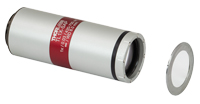
Click to Enlarge
The TL1X-SAP objective includes a removable wave plate that is attached via magnets to the end of the objective barrel. White markings on the end of the barrel and a black dot on the wave plate serve as reference points when rotating the wave plate.
- Infinity-Corrected Apochromatic Design Corrects Chromatic Aberrations Across the Visible Spectrum
- Ideal for Imaging or Focusing Laser Light
- M25 x 0.75 or M32 x 0.75 Threading
- Designed for a Tube Lens Focal Length of 200 mm
- Click Here for Full Presentation
Thorlabs offers super apochromatic microscope objectives with 1X, 2X, 4X, or 10X magnification, and a plan apochromatic 15X objective with improved visible performance. The objectives are designed to provide axial color correction over a wide field of view with no vignetting over the entire field. Each objective is designed for use with a tube lens focal length of 200 mm and has optical elements that are AR-coated for improved transmission. For more details on these objectives, please click the info icons (![]() ) below or see the full presentation.
) below or see the full presentation.
TL10X-2P Super Apochromatic Microscope Objective
Our 1X telecentric objective is ideal for machine vision applications and features a removable magnetic waveplate that minimizes back reflections when used with an epi-illuminated system, thus enabling an increase in contrast; see the image to the right. Our 2X and 4X objectives pair low magnification with NAs of 0.10 and 0.20, respectively, making them ideal for widefield imaging. Lastly, our 10X and 15X objectives are designed for multiphoton imaging applications and provide excellent transmission out to 1300 nm. The 10X and 15X objectives have correction collars that allow adjustment for spherical aberrations introduced by imaging through aqueous solutions or thick cover glasses, without the need for water dipping or oil immersion. The TL15X-2P objective additionally features a locking mechanism to fix the correction collar in place for improved repeatability.
All objectives are shipped in an objective case comprised of a lid and container; please see the table to the upper right for compatible replacement cases for each objective. Each objective housing is engraved with the item #, magnification, NA, wavelength range, and working distance. The housings are designed for a tube lens of focal length 200 mm. The TL1X-SAP, TL2X-SAP and TL4X-SAP objectives have M25 x 0.75 external threading, while the TL10X-2P and TL15X-2P objectives have M32 x 0.75 external threading. To use the objectives with a different thread standard, please see our microscope objective thread adapters.
The TL1X-SAP, TL2X-SAP and TL10X-2P objectives have parfocal lengths of 95.0 mm, while the TL4X-SAP and TL15X-2P objectives have 60.0 mm and 75.0 mm parfocal lengths, respectively (see the Specs tab for complete specifications). To use these objectives alongside each other, we offer parfocal length extenders; for example, the PLE351 parfocal length extender can be used to increase the parfocal length of the TL4X-SAP objective from 60.0 mm to 95.0 mm.

- AR Coated for 240 - 360 nm
- Ideal for Laser Focusing and UV Imaging Applications
- Diffraction-Limited Performance
- Designed for a Tube Lens Focal Length of 200 mm
- 10X, 20X, or 50X Magnification
Thorlabs MicroSpot objectives provide long working distances while keeping axial focal shift low. Their optical design is chromatically optimized in the UV wavelength range. Diffraction-limited performance is guaranteed over the entire clear aperture. These objectives are ideal for laser cutting, surgical laser focusing, and spectrometry applications. They can also be used for scanning and micro-imaging applications like brightfield imaging under narrowband, UV laser illumination. Each objective is shipped in an objective case comprised of an OC2M26 lid and an OC24 canister.
Each objective is engraved with its class, magnification, numerical aperture, wavelength range, a zero (noting that it is to be used to image a sample without a cover glass), and optical field number. For an explanation of the defining properties of these objectives, please see the Objective Tutorial tab.
Thorlabs can provide these objectives with custom AR coatings on request by contacting Tech Support; options include broadband NUV (325 nm - 500 nm), dual band (266 and 532 nm), and laser line (248 nm, 266 nm, 355 nm, or 532 nm). We also offer additional MicroSpot objectives for laser-focusing applications in the UV as well as visible and near-IR wavelengths.
| Item # | Wavelength Range |
Ma | WD | EFL | NA | EPb | Resolutionc | Typical Transmission |
OFN | PFL | Cover Glass Thickness |
AR Coating Reflectanced |
Pulsed Damage Threshold |
Objective Threading |
|---|---|---|---|---|---|---|---|---|---|---|---|---|---|---|
| LMUL-10X-UVB | 240 - 360 nm | 10X | 20.0 mm | 20 mm | 0.25 | 10.0 mm | 0.9 µm | Raw Data |
24 | 95.0 mm | 0 mm | (240 - 360 nm) |
5.0 J/cm2 (355 nm, 10 ns, 20 Hz, Ø0.342 mm) |
W26 x 0.706; 5 mm Depth |
| LMUL-20X-UVB | 20X | 15.3 mm | 10 mm | 0.36 | 7.2 mm | 0.6 µm | Raw Data |
|||||||
| LMUL-50X-UVB | 50X | 12.0 mm | 4 mm | 0.42 | 3.4 mm | 0.5 µm | Raw Data |

- AR-Coated for 400 - 1100 nm
- Axial Color Corrected for 436 - 850 nm
- Ideal for Laser Focusing; Brightfield, Darkfield, and Fluorescence Microscopy; and Two-Photon Imaging
- Designed for a Tube Lens Focal Length of 200 mm
- 50X Magnification
Thorlabs offers a High-Resolution Plan Apochromatic Improved Visible (APO VIS+) Microscope Objective for 400 to 1100 nm which provides axial color correction over a wide field of view with no vignetting over the entire field. Compared to common apochromatic microscope objectives, which are typically axial color corrected from the 436 nm (g-line) to 656 nm (C-line), our PLAN APO VIS+ objective has an extended corrected wavelength range from 436 nm (g-line) to 850 nm. The objective is designed for use with a tube lens focal length of 200 mm and has optical elements that are AR-coated for improved transmission between 400 nm and 1100 nm. For more details on these objectives, please click the info icon (![]() ) below. Our 50X objective has a high numerical aperture (NA) of 0.75, making it ideal for applications requiring high-resolution such as laser focusing; brightfield, darkfield, and fluorescence microscopy; and two-photon imaging. Thorlabs offers the objective case (Item #s OC2M26 and OC24) separately as a replacement if the case shipped with each of these objectives is lost or broken.
) below. Our 50X objective has a high numerical aperture (NA) of 0.75, making it ideal for applications requiring high-resolution such as laser focusing; brightfield, darkfield, and fluorescence microscopy; and two-photon imaging. Thorlabs offers the objective case (Item #s OC2M26 and OC24) separately as a replacement if the case shipped with each of these objectives is lost or broken.
This objective is engraved with its class, magnification, numerical aperture, a zero (noting that it is to be used to image a sample without a cover glass), and optical field number. For an explanation of the defining properties of this objective, please see the Objective Tutorial tab.

- Infinity-Corrected Plan Achromat Design
- Ideal for Imaging or Focusing Laser Light
- RMS (0.800"-36) Threading
- Designed for a Tube Lens Focal Length of 180 mm
- 45.06 mm Parfocal Length
These infinity-corrected, imaging microscope objectives for visible wavelengths provide 4X, 10X, 20X, or 40X magnification. With their high numerical apertures (NA) and large magnifications, they are suitable for focusing or collimating laser light. These Olympus objectives are ideal for imaging applications due to their diffraction-limited performance across the entire visible spectrum. Alternatively, they can be used to focus light to a diffraction-limited spot, enabling efficient coupling of monochromatic or broadband light into a waveguide or fiber. Each of these objectives is suitable for use in brightfield microscopy, while the RMS10X, RMS20X, and RMS40X also offer excellent performance in darkfield imaging.
Their designation as plan achromats indicates that they are flat field and aberration corrected at two different wavelengths in the visible spectrum, leading to better spherical and chromatic corrections and superb field flatness. These achromatic objectives have an ultra-wide antireflection coating and standard RMS threading. To use these objectives with a different thread standard, please see our microscope objective thread adapters.
| Item # | Wavelength Range | Ma | WD | EFL | NA | EPb | Resolutionc | OFN | PFL | Cover Glass Thickness |
Performance Graphs |
AR Coating Reflectance |
Pulsed Damage Threshold |
Objective Threading |
|---|---|---|---|---|---|---|---|---|---|---|---|---|---|---|
| RMS4X | Visible | 4X | 18.5 mm | 45 mm | 0.10 | 9 mm | 3.4 µm | 22 | 45.06 mm | 0 - 0.17 mm | Proprietary | Proprietary | - | RMS; 4.5 mm Depth |
| RMS10X | 10X | 10.6 mm | 18 mm | 0.25 | 9 mm | 1.3 µm | ||||||||
| RMS20X | 20X | 1.2 mm | 9 mm | 0.4 | 7.2 mm | 0.8 µm | 0.17 mm | RMS; 4.8 mm Depth |
||||||
| RMS40X | 40X | 0.6 mm | 4.5 mm | 0.65 | 5.9 mm | 0.5 µm | 0.17 mm | RMS; 4.5 mm Depth |

- Infinity-Corrected Plan Fluorite Design
- Ideal for Imaging or Focusing Laser Light
- RMS (0.800"-36) Threading
- Designed for a Tube Lens Focal Length of 180 mm
- 45.06 mm Parfocal Length
These infinity-corrected, imaging microscope objectives for visible to NIR wavelengths provide 4X, 10X, 20X, 40X, or 60X magnification. Plan Fluorite objectives, also called a plan semi-apochromat, are corrected for four wavelengths. These are well suited for color photomicrography. The RMS60X-PFC features variable coverslip correction; it has a rotating correction collar that changes the distance between the objective elements, allowing the coverslip correction to be adjusted from 0.11 mm to 0.23 mm.
All of these objectives are excellent for brightfield microscopy, while the RMS10X-PF, RMS20X-PF, RMS40-PF, and RMS60X-PFC objectives are also excellent for DIC microscopy. These objectives use standard RMS threading. To use these objectives with a different thread standard, please see our microscope objective thread adapters.
| Item # | Wavelength Range | Ma | WD | EFL | NA | EPb | Resolutionc | OFN | PFL | Cover Glass Thickness |
Performance Graphs |
AR Coating Reflectance |
Pulsed Damage Threshold |
Objective Threading |
|---|---|---|---|---|---|---|---|---|---|---|---|---|---|---|
| RMS4X-PF | Visible to NIR | 4X | 17 mm | 45 mm | 0.13 | 11.7 mm | 2.6 µm | 26.5 | 45.06 mm | 0 - 0.17 mm | Proprietary | Proprietary | - | RMS; 4.5 mm Depth |
| RMS10X-PF | 10X | 10 mm | 18 mm | 0.3 | 10.8 mm | 1.1 µm | 0 - 0.17 mm | |||||||
| RMS20X-PF | 20X | 2.1 mm | 9 mm | 0.5 | 9 mm | 0.7 µm | 0.17 mm | |||||||
| RMS40X-PF | 40X | 0.51 mm | 4.5 mm | 0.75 | 6.8 mm | 0.4 µm | 0.17 mm | |||||||
| RMS60X-PFC | 60X | 0.2 mm | 3 mm | 0.9 | 5.4 mm | 0.4 µm | 0.11 - 0.23 mmd | RMS; 4.7 mm Depth |

- Infinity-Corrected Plan Fluorite Design
- Ideal for Imaging or Focusing Laser Light
- M25 x 0.75 Threading
- Designed for a Tube Lens Focal Length of 200 mm
- 60 mm Parfocal Length
The Nikon Plan Fluorite Objectives provide 4X, 10X, 20X, 40X, or 60X magnification. They are designed to have high transmission in the UV to NIR wavelength range and to produce flat images across the field of view. These multi-purpose objectives can be utilized for brightfield microscopy, fluorescence microscopy, and polarization-sensitive observations. The N10X-PF, N20X-PF, N40X-PF, and N60X-PF objectives are also good for both darkfield and DIC microscopy.
Each objective is designed for use with a tube lens focal length of 200 mm and is compatible with our DIY Cerna® Systems. They use M25 x 0.75 threading; to use these objectives with a different thread standard, please see our microscope objective thread adapters.
These objectives are designed for use from -18 °C (0 °F) to 60 °C (140 °F) and are not recommended for use at extreme temperatures.
| Item # | Wavelength Range | Ma | WD | EFL | NA | EPb | Resolutionc | OFN | PFL | Cover Glass Thickness |
Performance Graphs | AR Coating Reflectance |
Pulsed Damage Threshold | Objective Threading |
|---|---|---|---|---|---|---|---|---|---|---|---|---|---|---|
| N4X-PF | UV to NIR | 4X | 17.2 mm | 50 mm | 0.13 | 13 mm | 2.6 µm | Not Available | 60 mm | 0 - 0.17 mm | Proprietary | Proprietary | - | M25 x 0.75; 3.6 mm Depth |
| N10X-PF | 10X | 16 mm | 20 mm | 0.3 | 12 mm | 1.1 µm | 25 | 0.17 mm | M25 x 0.75; 5 mm Depth |
|||||
| N20X-PF | 20X | 2.1 mm | 10 mm | 0.50 | 10 mm | 0.7 µm | Not Available | 0.17 mm | ||||||
| N40X-PF | 40X | 0.66 mm | 5 mm | 0.75 | 7.5 mm | 0.4 µm | 25 | 0.17 mm | M25 x 0.75; 5.1 mm Depth |
|||||
| N60X-PF | 60X | 0.31 - 0.4 mm | 3.3 mm | 0.85 | 5.7 mm | 0.4 µm | 25 | 0.11 - 0.23 mmd | M25 x 0.75; 5 mm Depth |

- Long Working Distance
- Infinity-Corrected Plan Apochromat Design
- W26 x 0.706 Threading
- Designed for a Tube Lens Focal Length of 200 mm
- 95 mm Parfocal Length
Thorlabs offers Mitutoyo Plan Apochromat Objectives with 5X, 7.5X, 10X, 20X, 50X, or 100X magnification. They feature a flat field of focus and chromatic correction over their operating ranges: either 436 nm to 656 nm or 480 nm to 1800 nm. The long working distance provides a wide space between the lens surface and the object making them ideal for machine vision applications. Each objective is engraved with its class, magnification, numerical aperture, a zero (noting that it is to be used to image a sample without a cover glass), and the tube lens focal length for which the specified magnification is valid. For an explanation of the defining properties of these objectives, please see the Objective Tutorial tab. If the case shipped with each of these objectives is lost or broken, Thorlabs offers an objective case (item #s OC2M26 and OC24) that can be used as a replacement.
The objectives have external W26 x 0.706 threads; to use these objectives with a different thread standard, please see our microscope objective thread adapters. These objectives do not feature adjustment to correct for cover glass thickness and should be used without a cover slip.
 Products Home
Products Home




















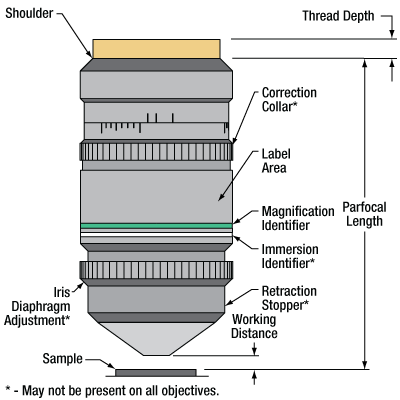
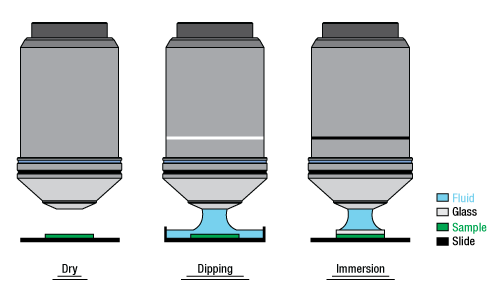
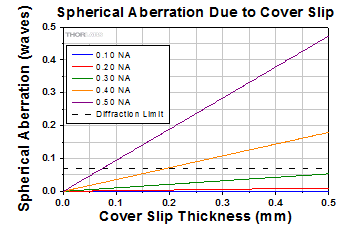

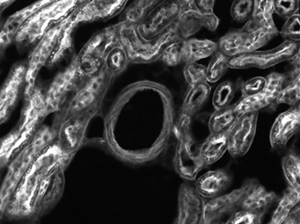
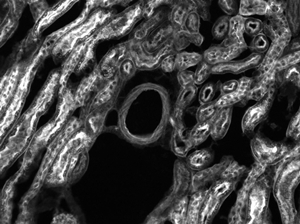

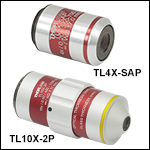
 Zoom
Zoom
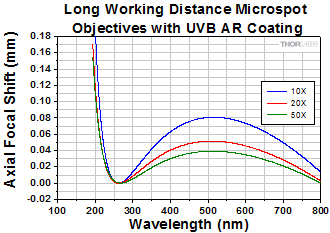
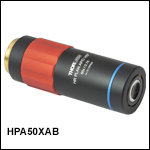
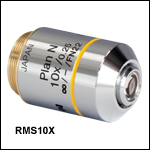
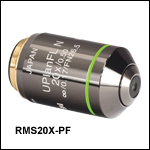
 Click to Enlarge
Click to Enlarge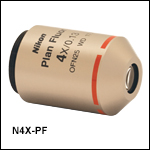
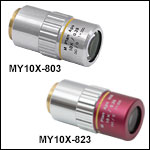
 Microscope Objectives, Dry
Microscope Objectives, Dry